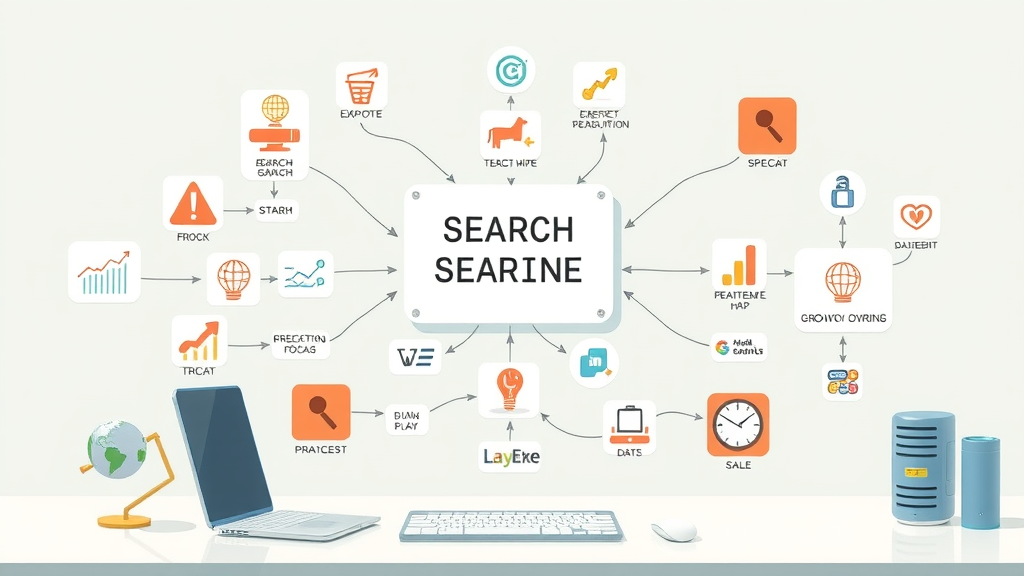Did you know over 90% of online experiences start with a search engine , but fewer than one in ten users ever click past the first page of results? If you feel like your website or business is trapped in search engine obscurity, you’re not alone. Mastering search engine algorithms is the golden ticket to boosting your visibility, outpacing competitors, and securing a prime spot on that coveted first search engine results page . In this guide, you’ll uncover the hidden rules behind how search engines work, how their search algo determine what you see, and actionable steps to dominate the rankings—fast.
How Search Engine Algorithms Shape Every Search: Unveiling the Hidden Rules
Every time you type a query into Google, Bing, or any other search engine, you trigger a complex process powered by sophisticated search engine algorithms . These invisible rules quietly decide which web pages get the spotlight and which are lost in obscurity, shaping the way we discover information online. While you see a simple list of results, the selection and ranking are the end-products of an intense digital race, factoring in millions of signals in mere milliseconds.
The primary goal of any search engine is to deliver the most relevant and useful results based on your exact search query . To do so, search engines utilize sophisticated engine algorithms that constantly evaluate web content, site structure, backlinks, user engagement signals, and much more. By understanding and adapting to these search algorithms , businesses and marketers can vastly increase their odds of appearing on the first page—where over 90% of all search traffic happens.

- You Will Discover:
- How search engine algorithms determine visibility on search engines
- Key ranking factors and why they matter
- Strategies to thrive after algorithm updates
- Actionable steps for improving ranking on the search engine results page
"Over 90% of online experiences begin with a search engine, yet fewer than 1 in 10 users look past page 1. Mastering search engine algorithms is the gatekeeper to online success."
Understanding Search Engine Algorithms: What Every Marketer and Site Owner Must Know
Defining Search Engine Algorithms, Search Algorithms, and Engine Algorithms
At their core, search engine algorithms are complex sequences of rules, formulas, and calculations designed to sort, filter, and rank web pages according to relevance and quality. These engine algorithms are responsible for evaluating billions of pages and delivering the most relevant results for every search query . The term “ search algorithm ” may refer to the overarching process or to any of the sub-algorithms handling aspects like links, structured data, or user signals.
Marketers and site owners need to grasp that search algorithms are dynamic: what works today for your search engine ranking could shift dramatically after the next algorithm update . For instance, algorithms now give priority to quality content and user experience signals, reducing the impact of outdated tactics like keyword stuffing. Understanding how search engines work —and the factors they prioritize—is paramount to staying visible and relevant in an ever-evolving digital landscape.

Why Search Engines Use Algorithms: The Science of Delivering Relevant Results
Search engines face the enormous challenge of processing billions of search queries daily and serving the most relevant results in fractions of a second. Without robust engine algorithms , displaying useful, accurate, and fair search results at scale would be impossible. The science lies in analyzing web pages for content quality , keywords matching user intent, backlinks from trusted sources, and more.
The use of algorithms ensures consistent, objective, and automated ranking, minimizing human error and subjective bias. As users’ search habits evolve, so do the search engines’ methods for interpreting intent and filtering out spam or low-quality content. The end goal is to make certain every search result truly matches what the searcher needs—maintaining user trust and keeping people coming back for all their information needs.
How Search Engines Work: The Foundation of Every Search Algorithm
The Search Process: Crawling, Indexing, and Ranking
All search engines follow a structured three-step process that underpins every successful search algorithm : crawling, indexing, and ranking. Crawling involves web “spiders” (robotic programs) scouring the Internet to discover new and updated web pages . Indexing follows, where these pages are stored and organized in vast databases, effectively creating a massive, searchable library.
The magic happens in the ranking phase. When you submit a search query , the engine algorithm analyzes the indexed content, scoring it against hundreds of criteria to deliver a prioritized results page . Factors like content quality , relevance, and user experience help determine which entries appear on the coveted first page. Understanding each stage is key—if your content isn’t crawled, indexed, and correctly ranked, it doesn’t stand a chance in the search engine results race.

What Happens Behind Every Search Engines Work Moment?
Each time a user enters a search, the engine algorithm leaps into action. The process begins by parsing the query—determining not just the keywords but the intent behind them. Advanced search algorithms factor in recent trends, semantic connections, and even previous user behavior to predict what information will best answer the user’s needs.
Once the intent is clear, the system searches its index for the most relevant web pages . From there, a cascade of ranking factors such as mobile-friendliness, site speed, and trustworthiness influence the order in which results appear. This lightning-fast sequence is a marvel of engineering and ensures that, whether your query is “how search engines work” or “best Italian restaurants near me,” you receive tailored, high-quality suggestions every single time.
Major Types of Search Engines and Their Algorithms
Overview of Common Search Engine Types: Web, Vertical, Hybrid, and Metasearch
Not all search engines are created equal. Broadly, they fall into four main categories—each serving unique purposes and user intents with their own specialized search engine algorithms :
- Web Search Engines (like Google, Bing): Index the general web and are the most commonly used.
- Vertical Search Engines (like YouTube, Yelp): Focus on niche content, such as videos, local businesses, or images.
- Hybrid Search Engines: Pull results from both general and specialized databases, customizing mixed results for the user.
- Metasearch Engines (like DuckDuckGo): Aggregate results from multiple search engines, prioritizing diverse perspectives or privacy features.
Each leverages its own blend of engine algorithms and ranking factors to best serve its audience, but all share a commitment to surfacing the most relevant results for the user’s query.

How Search Algorithms Differ Between Google Search, DuckDuckGo, Bing, and Others
Though the fundamentals remain the same, individual search engines craft unique search algorithm formulas. Google Search , for example, is renowned for machine learning, AI-driven personalization, and a fierce focus on user experience . Bing combines traditional ranking factors with social signals and deep multimedia indexing. DuckDuckGo, in contrast, is designed around privacy—downplaying user profiling while still delivering relevant results by sourcing from a dozen partner indexes and its own engine algorithms .
Understanding these differences is crucial for SEO success. Pages that rank on Google may not perform as well on Bing or DuckDuckGo, due to differences in how ranking factors like page authority, backlink profiles, and on-page content quality are weighed. As the digital landscape continually evolves, staying abreast of each engine’s unique priorities is a must for competitive, cross-platform visibility.
A Deep Dive Into Google Search: Search Engine Algorithm at Scale
Critical Ranking Factors in Google's Search Algorithm
Google’s search engine algorithm is the industry’s most sophisticated, considering over 200 signals in real-time. Chief among these ranking factors are content quality , mobile-friendliness, site speed, backlink authority, and user engagement. Google’s “ E-E-A-T ” model (Experience, Expertise, Authoritativeness, Trustworthiness) guides the evaluation of every web page in its index.
Additionally, Google prioritizes seamless user experience . Factors like Core Web Vitals (page load times, interactivity, and visual stability) have become pivotal. Structured data, which enables featured snippets and rich search results, is another crucial ranking boost. For SEO practitioners, a laser focus on quality content and technical optimization is required to earn (and keep) high spots on the Google search engine results page.
Evolution of Google’s Engine Algorithms: Past, Present, and Updates
Google’s journey is marked by continual evolution. Early “link-based” engine algorithms like PageRank set foundational guidelines: pages with more (and better) backlinks ranked higher. As spam and manipulation techniques proliferated, major algorithm updates like Panda, Penguin, Hummingbird, and BERT forced a shift toward semantics, relevancy, and intent. These changes penalized low-quality content, excessive keyword stuffing, and shallow link-building strategies.
Today, machine learning and artificial intelligence are the driving force behind Google’s search algo improvements. Real-time processing, user-centric updates, and the integration of new ranking factors means that successful SEO is always a moving target. By staying informed about these shifts, you maintain the agility needed for sustained ranking success.

Search Engine Algorithms in Action: Ranking Factors Decoded
| Ranking Factor | Impact on Rankings | Example |
|---|---|---|
| Content Quality | Very High | Comprehensive Guides |
| User Experience | High | Page Speed, Mobile UX |
| Backlinks | High | Authoritative Sources |
| Relevance of Keywords | High | Matching User Intent |
| Technical SEO | Medium | Structured Data, Sitemaps |
User Experience and Content Quality: Impact on Search Engine Results Page
Google and other search engines are relentless in their pursuit of positive user experience . Elements like fast load times, intuitive layouts, and mobile optimization can tip the scales in your favor on the search engine results page . However, none of this matters if your content quality doesn’t satisfy the searcher’s intent. Comprehensive, trustworthy, and regularly updated quality content signals authority, while superficial blog posts or duplicate content will put your site at risk after the next algorithm update .
To consistently win in search ranking , focus first on understanding what users want from each search query —and then create content that exceeds those expectations. Combine this with a frictionless user experience , and you’ve unlocked two of the top ranking factors for any engine results page .

Search Ranking Volatility After Algorithm Change and Algorithm Updates
If you’ve ever witnessed dramatic fluctuations in your site’s performance on the search engine results page , chances are you’ve experienced an algorithm change firsthand. Every year, Google and other engines release hundreds of tweaks—some minor, some game-changing. When a major algorithm update lands, entire industries can be reshuffled overnight.
Sites that rely on manipulative strategies—like keyword stuffing or thin content—are especially vulnerable to sudden ranking drops. On the flip side, those who invest in evergreen, quality content and optimal user experience often find their visibility improves after each algorithm update . The key is to build SEO strategies around long-term value, not short-term tricks.
Adapting to Algorithm Updates: How to Respond to Search Engine Algorithm Shifts
Proven Strategies to Survive Major Algorithm Update Rollouts
The best antidote to algorithm update anxiety is proactive adaptation. First, prioritize site health by regularly removing outdated or low-value pages and focusing on comprehensive, authoritative content. Next, monitor your analytics for sudden changes—drops in organic traffic, keyword rankings, or engagement rates are major clues that an algorithm change has impacted your site.
Diversify your search presence: don’t put all your eggs in the Google basket. Optimize for other engines like Bing and DuckDuckGo, which may weigh ranking factors differently and offer valuable alternative traffic streams. Consider a holistic SEO approach—strengthen technical SEO, bolster backlink quality, and keep user experience at the forefront of every update or new launch.

Importance of Monitoring Algorithm Change and Updates
Monitoring for algorithm changes isn’t just best practice—it’s survival. By subscribing to official channels, tracking SEO industry news, and using alert systems (like Google Search Console), you’ll spot subtle shifts before they spiral into major losses. Being vigilant allows site owners to quickly adjust content, technical settings, or linking strategies, minimizing the impact of unforeseen algorithm updates .
Remember, most successful recoveries stem from swift, data-informed responses. Keep detailed logs of your SEO changes, run frequent audits, and never stop testing. The digital landscape moves fast; only those tracking the tides of change will consistently stay visible on the search engine results page .
Optimizing for Search Engine Algorithms: Actionable Best Practices
- Checklist for Algorithm-Friendly SEO:
- Consistent content updates and quality improvements
- Prioritize mobile and core web vitals for user experience
- Build high-quality backlinks from trusted sources
- Implement complete on-page SEO (titles, meta, structured data)
“Algorithm-friendly SEO” means optimizing your site for today’s—and tomorrow’s—search standards. Regularly assess and update older content, ensuring every web page meets current quality and relevance standards. Invest in technical performance: mobile usability, fast loading times, and secure connections are no longer optional. Backlinks from reputable sources act as trust signals, giving your content the authority search engines need to rank it higher.
Mistakes to Avoid When Optimizing for Search Engine Algorithm
The biggest mistake in today’s SEO is clinging to outdated tactics. Avoid “ keyword stuffing ” and low-quality guest posts, as these can invite penalties after a significant algorithm update . Over-optimizing anchor text, neglecting mobile users, and ignoring structured data are other red flags. Instead, prioritize clarity, value, and technical robustness in every aspect of your site.
Remember: search engines reward those who genuinely help users, not those who try to “game” the search algo . High-performing websites focus on their audience’s needs first, then meet the technical and strategic requirements of ever-changing engine algorithms .
Case Studies: Real-World Examples of Search Engines Work and Search Ranking Success

From Penalty to Page 1: Overcoming Search Engine Ranking Drops After Algorithm Updates
When a leading e-commerce site was struck by a harsh algorithm update , it fell from the top ten to page five overnight. By analyzing the search engine algorithm updates, they identified issues with thin content quality and old, toxic backlinks. The team overhauled key web pages with in-depth information and pruned their backlink profile, recovering—and even surpassing—their previous search ranking within six months.
How Consistent SEO Adaptation Wins Engines' Favor
In another case, a popular blog consistently updated its content, tuned its technical SEO, and responded swiftly to emerging algorithm changes . This adaptive strategy resulted in steady traffic growth and bulletproofed rankings against frequent engine algorithm tweaks. The lesson: evolution and vigilance, not shortcuts, keep your site on the leading edge of the search engine results page .
What algorithm is used in search engines?
Answer: Common Search Algorithms Powering Today's Top Search Engines
Modern search engines use a blend of proprietary, AI-driven search algorithms . Examples include Google’s BERT and RankBrain, Bing’s Tiger and Deep Search, and DuckDuckGo’s privacy-focused Yandex and crowd-sourced blends. All use a combination of content quality , user signals, and technical factors to ensure the most relevant results for each search query .
Does DuckDuckGo have an algorithm?
Answer: How DuckDuckGo's Search Algorithm Prioritizes Privacy
Yes, DuckDuckGo operates its own search algorithm , combining results from sources like Bing, its own web crawler, and other partners. What sets it apart is its privacy-first philosophy—searches aren’t tracked or profiled, and engine algorithms don’t adapt based on past user behavior. As a result, every user sees similar, unbiased search ranking placements.
What are the 5 types of search engines?
Answer: The Most Popular and Widely Used Search Engine Types
The five primary types of search engines are: 1) Web (Google), 2) Vertical (YouTube), 3) Metasearch (DuckDuckGo), 4) Hybrid (combines web and vertical), and 5) Enterprise (intranet/business use). Each relies on unique search engine algorithms tailored to their audience and function.
What is the SEO algorithm?
Answer: Defining and Demystifying SEO Algorithms for Modern Marketers
An “ SEO algorithm ” usually refers to the sections of a search engine algorithm that govern how organic rankings are determined. This includes on-page signals (content, structure), off-page trust factors (backlinks), technical health, and user engagement. Mastering SEO means understanding—and adapting to—these complex, ever-changing rules.
Frequently Asked Questions on Search Engine Algorithms
- How often do search engine algorithms update? Search engines like Google release updates almost daily, but only the most significant algorithm changes are announced. Staying proactive with continuous improvement is crucial.
- Are all search engine algorithm updates announced by Google? No, many updates happen silently. Major changes (like Panda, Penguin, or core algorithm updates) are often announced, but smaller tweaks usually aren’t publicized.
- Can websites recover from a search algorithm penalty? Yes. By identifying and fixing the underlying SEO or content issues, most sites can gradually regain—and even improve—their search ranking .
- What is the most important ranking factor in Google search engine algorithms? Content quality and genuine relevance to user intent have consistently held the most weight, followed closely by technical SEO and authoritative backlinks.
- Should I focus more on content quality or technical SEO for engines work? Both matter, but start with content quality . Without valuable content, technical SEO improvements alone won’t deliver top results.
Visual Guide: How Search Engine Algorithms Work (VIDEO 1)
For a dynamic, step-by-step explanation, watch our explainer video breaking down how search engines work —from web crawling to ranking and presenting results.
Comparing Search Engine Updates Over Time (VIDEO 2)
Learn how evolution in major search engine algorithms like Google’s affects ranking, visibility, and digital strategy, with timelines and expert commentary.
Recent Algorithm Updates and Their Impact on Top Search Engines (VIDEO 3)
This deep dive video examines the latest algorithm updates and unpacks their effects on search visibility for businesses and brands across major platforms.
Expert Insights: Navigating Search Engine Algorithm Changes (VIDEO 4)
Top SEO strategists share their secrets and tactics for staying ahead of search engine algorithm shifts and ensuring long-term ranking wins.
Key Insights to Remember About Search Engine Algorithms and Ranking Success
- Search engine algorithms are increasingly focused on user intent and content quality
- Continuous monitoring of updates is necessary to avoid ranking losses
- Algorithm-friendly SEO delivers compounding results over time
- Adapting quickly to algorithm changes ensures continuous search ranking growth
Ready to Master Search Engine Algorithms? Schedule a Free Strategy Session Today! ( https://hub.prospectrocket.com/AR/eymcalendar )
Take actionable steps—schedule your free strategy session and get expert guidance tailored to your website’s unique needs for search engine algorithm success.
Conclusion:
Take action now: Audit your site quality, monitor algorithm changes, and consistently update your SEO strategies to win the ongoing battle for top search engine rankings.
Understanding search engine algorithms is crucial for enhancing your website’s visibility and achieving higher rankings. To delve deeper into this topic, consider exploring the following resources:
-
“Behind the Algorithm: Understanding Search Engines” : This article provides an in-depth look at how search engines operate, including insights into PageRank, content quality assessment, and the role of machine learning in modern search algorithms. ( algocademy.com )
-
“Search Engine Algorithms Explained” : This resource outlines the evolution of search engine algorithms, detailing major updates like Panda, Penguin, Hummingbird, and BERT, and their impact on search engine results pages (SERPs). ( magicspace.co )
By exploring these resources, you’ll gain a comprehensive understanding of search engine algorithms and practical strategies to improve your website’s search rankings.
 Add Row
Add Row  Add
Add 




Write A Comment